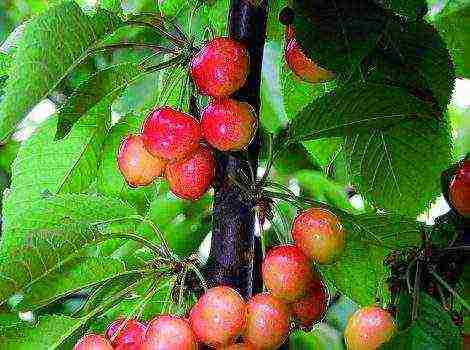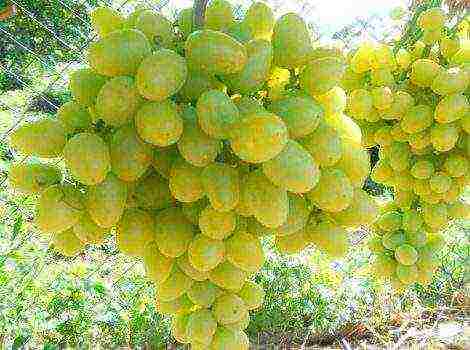Content
- 1 Varieties and their types
- 2 The best varieties for the Moscow region and central Russia
- 3 The best gooseberry varieties with large fruits
- 4 The best winter-hardy gooseberry varieties
- 5 The best studless gooseberry varieties
- 6 Conclusion
- 7 White Nights
- 8 Candy
- 9 Pink 2
- 10 Seedling Lefort
- 11 Cooperator
- 12 Belarusian sugar
- 13 Russian yellow
- 14 Sirius
- 15 Beryl
- 16 Chernomor
Gooseberry culture is widespread throughout Russia. The best gooseberry varieties for Siberia were bred by breeders of the N. M.A. Lisavenko, Minusinsk experimental station of gardening and melon growing and Buryat fruit and berry experimental station.
Since 1937, successful work has been underway to develop regionalized gooseberry varieties. As a result, more than half of the gooseberry species registered in the State Register of Plants of the Russian Federation are suitable for cultivation in Siberia.
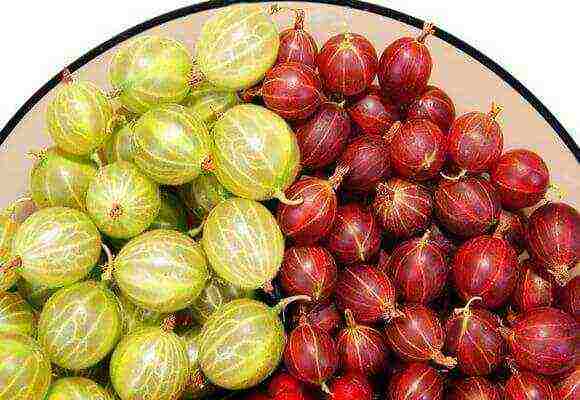
Varieties for Siberia
The territory of Siberia is divided into two regions - Western Siberia and Eastern Siberia. These areas are quite different from each other in terms of climatic conditions. If for Western Siberia more than 20 acclimatized gooseberry species have been bred, then only 7 registered in the State Register are suitable for cultivation in Eastern Siberia.
Below is a description of varieties suitable for cultivation throughout Siberia.
There is a unique gooseberry that is grown from Ukraine to the Far East. This is the Russian variety, bred in 1959. The species is a classic of Soviet selection, still unsurpassed in many respects.
Russian
It grows as a bush of medium height with arcuate shoots, covered in the lower part with sparse thorns. Cherry berries of medium to large size and sweet and sour taste ripen at the end of July. He is not afraid of either winter frosts or summer droughts. Stably harvested, does not get sick.
The disadvantage is the spreading of the bush at a young age, which can be easily forgiven for a variety that has no other flaws.
Candy
The name itself reflects the main advantage of the variety - sweet berries. Gooseberry has a specific sweet and sour taste. It is devoid of acidic flavor. There are thorns on the branches, but they are located below the berry picking area and do not interfere with the harvest. Pink berries do not crumble and hang on the bushes for a long time, acquiring a really candy taste and aroma.
The species is very unpretentious, excellent drought resistance, good productivity and resistance to infections can be added to the high winter hardiness. It is difficult to find flaws in the variety, except that the average resistance to septariosis.
Reliable
Medium early variety, berries ripen at the end of July. The berries are small in size, but have a good taste and excellent aroma. With this species, the gardener will never be left without berries. The gooseberry tolerates low temperatures well without harming the crop. It is resistant to fungal infections. The spine of the shoots is weak.
The disadvantage is the tendency of its thin shoots to root tops and small berries.
Ural emerald
An unsurpassed variety in its characteristics. A medium-sized bush is easy to hide under the snow. Beautiful shiny foliage, emerald green berries with light veins, crimson flower buds - all this makes the bush a decoration of the site.
Large berries with a delicate and soft skin are juicy, very tasty. A bucket of berries is harvested from each bush, the yield of an adult bush reaches 7 kg.
The disadvantage of the variety is the presence of thorns, fast crumbling during ripening, thickening of the bush and low resistance to fungal diseases.
Cherny Cherkashina
The first gooseberry variety without thorns, released in Siberia. The almost black berries are teardrop-shaped and have a sweet and sour taste. The disadvantages are the small size of the berries and poor shoot formation.
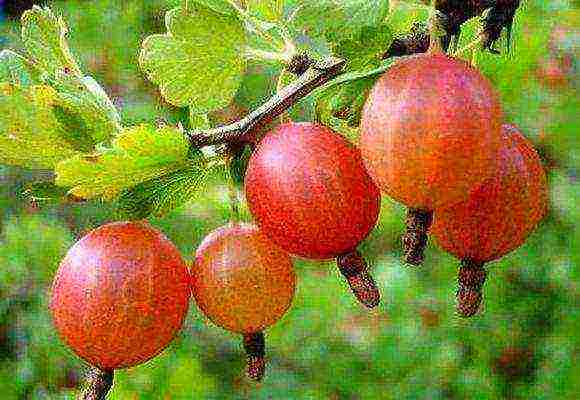
Shershnevsky
The description of the variety should start with a review of the excellent sweet taste and large dark pink berries. More than 7 kg of berries can be removed from the gooseberry bush annually. A distinctive feature is the upper third of the shoots are purple. The thorns are located at the bottom of the branches.
The bush is not only resistant to unfavorable climatic conditions and infections, it is not even damaged by pests. The only disadvantage is the spine of the shoots.
Muromets
Zoned for Irkutsk Oblast and Krasnoyarsk Krai. In addition to winter hardiness and early ripening, the variety is large-fruited and resistant to spheroteca. The green color of the berries with well-visible veins is set off by a light “tan” on the sunny side. The variety is self-fertile and yielding, grown in open form.
The disadvantage of the variety is the crumbling of the berries after ripening, the strong spine of the shoots and the average taste of the berries.
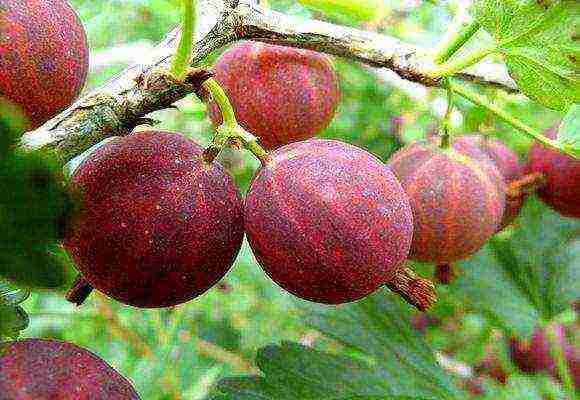
At the Novosibirsk zonal gardening station of the Russian Agricultural Academy, the popular Flamingo gooseberry variety has been bred. The medium-ripening variety has beautiful, versatile pink berries. The sweet taste and delicate aroma of the berries made this species very popular in the gardens of the region. The disadvantages include the presence of thorns.
There are several more promising varieties for the Siberian region that are being tested for suitability for growing in these lands:
- Pink-2;
- Beryl;
- People's;
- Salute;
- Chernomor;
- Bright.
The varieties are being tested at the Shushensky State Fruit and Berry Variety Testing Site in the Krasnoyarsk Territory and have shown themselves from an excellent side.
Gooseberry varieties are tested not only at state stations, but also in private nurseries and private gardens.
In addition to the listed varieties, for the Siberian region, it is possible to recommend species intended for zoning in other regions of the country, but successfully growing in Siberia with shelter for the winter.
The varieties that have passed tests in Siberia:
- Beryl;
- Grossular;
- Chelyabinsk besshorny;
- Green rain;
- Legin;
- Cooperator;
- Black drop;
- Prune;
- Senator;
- Affectionate;
- Oksamite;
- Sweet;
- Naughty man;
- Spring;
- Ural pink;
- Ural emerald.
The varieties for Siberia have different ripening periods, different colors and shapes, the gooseberry of these varieties has only two drawbacks - the bush grows either thickened or stunted.
Features of Siberian varieties
To obtain resistant varieties of gooseberries, breeders crossed winter-hardy American and European species with local species of Altai and Bureya gooseberries. From such a crossing, seedlings of high winter hardiness were obtained, but with small berries and a large number of thorns on the branches. Seedling deficiencies were eliminated by repeated crosses.
Gooseberries for the regions of Siberia must have a number of necessary qualities:
- winter hardiness;
- resistance to major fungal infections;
- early terms of fruiting.
The main feature of gooseberries, which are intended for cultivation in the Siberian region, is that they must be winter hardy. It must be remembered that frost-resistant varieties that can withstand 36–39 degrees of frost are not always suitable for cultivation in Siberian conditions.
Frost resistance is a characteristic of the kidneys, that is, the temperature that they can withstand. Winter hardiness is resistance not only to low temperatures, but also to thaws, sudden temperature changes, sunburn and winter desiccation, damping and soaking.
Important! For the Siberian region, gooseberry, like other berry bushes, is a covering crop.In principle, the branches can be easily bent in the ground for shelter for the winter.
Resistance to fungal diseases not only guarantees a stable annual harvest, but also the ripening of new shoots, good preparation for winter. Diseased bushes sharply reduce their winter hardiness. Why the bush will die: from infection or from a low temperature, it will no longer matter.
Important! Early ripening is important for bountiful harvests. Late and some medium-ripening varieties simply do not have time to ripen.
Moreover, not only berries should ripen, but also new shoots. Annual shoots that remain green will freeze even under cover. You can't expect a harvest from such varieties.
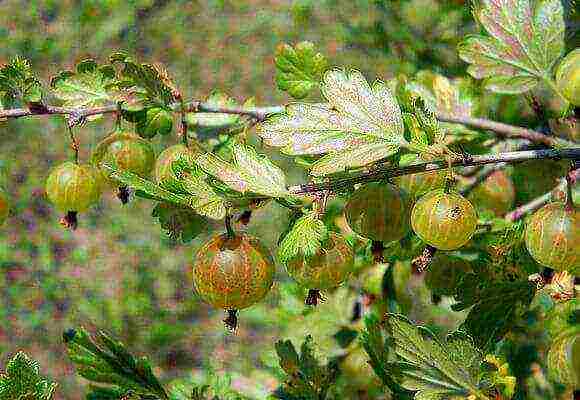
Just like in other regions of the country, Siberian gardeners want to grow gooseberries without thorns, with large fruits (at least 6 g) in their gardens. High yield (more than 4 kg / bush), self-fertility and early maturity, sweeter and more pillowy berries are optional, but very desirable characteristics of the varieties.
Planting gooseberries in Siberia, caring for it does not differ from measures for caring for a crop in central Russia. Unless it is advisable to pin the branches to the ground for the winter so that they are under the snow in winter. That's all the difference.
Conclusion
Gooseberries are the most promising berry crop for Siberia. Raspberries and currants are grown here in cover form, while gooseberries require cover only for the winter.
As a result of such an interest in this culture, the largest number of zoned varieties in the country have been bred specifically for the West Siberian region.
In the central regions of Russia, gooseberries are grown in almost every plot. A detailed description of the variety and photos presented in the article will help you choose the best type of gooseberry, both for a novice gardener and an amateur gardener.
Varieties and their types
The fruits of different varieties of gooseberries are different:
- Size and shape;
- Color (green, red, pink, yellow berries);
- The presence of thorns (thornless, strongly thorny and medium thorns varieties);
- Ripening period;
- Productivity.
Based on the reviews of summer residents, the best varieties of gooseberries include plants with a small number of straight shoots and a weak tendency to shoot. It is the bushes of such varieties that receive more sunlight and are well ventilated. These factors have a beneficial effect on the volume of the harvest and the palatability of the fruit.
The best varieties for the Moscow region and central Russia
"Grushenka"
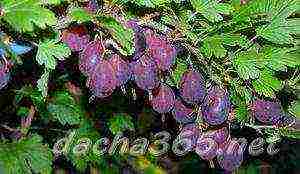 Medium-sized plant with drooping branches. The bushes have practically no thorns. The fruits are pear-shaped, small in size, weighing about 4.9 g per unit, the color of the skin changes depending on the degree of ripeness. Initially, the berries are pale reddish in color, when ripe are purple. The variety is recommended to be planted in the regions of central Russia, since Grushenka tolerates frost and hot, dry summers well. The variety does not suffer from diseases and viruses.
Medium-sized plant with drooping branches. The bushes have practically no thorns. The fruits are pear-shaped, small in size, weighing about 4.9 g per unit, the color of the skin changes depending on the degree of ripeness. Initially, the berries are pale reddish in color, when ripe are purple. The variety is recommended to be planted in the regions of central Russia, since Grushenka tolerates frost and hot, dry summers well. The variety does not suffer from diseases and viruses.
"Russian yellow"
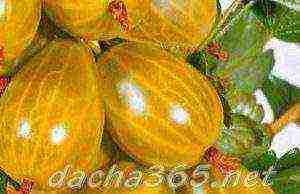 The plant is of yellow varieties and has medium spreading branches. The bushes are covered with a lot of thorns.
The plant is of yellow varieties and has medium spreading branches. The bushes are covered with a lot of thorns.
Berries are pear-shaped, yellowish in color, the weight of one unit is 6 grams. The fruits are covered with a layer of waxy coating.
"Russian yellow" is resistant to frost and does not suffer from drought, has immunity against viruses and diseases.
"Amber"
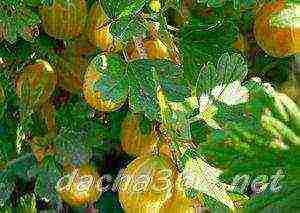 The height of the plant bushes is about 1.55 m. The branches are spreading, densely arranged and covered with thorns.
The height of the plant bushes is about 1.55 m. The branches are spreading, densely arranged and covered with thorns.
The berries are oblong, yellowish-orange in color, pleasant to the taste, the weight of one unit is from 5 to 6 grams.
"Amber" has an early ripening period and yields a consistently good harvest. The variety is frost and drought resistant.
"Kolobok"
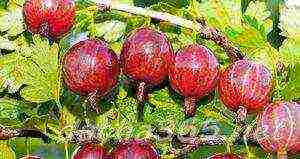 The lower part of the branches of the bush is covered with thorns. The plant is compact and medium in size. The berries are large, one weighs about 6.9 grams. The shape of the fruit is elongated, the skin color is light red. The pulp tastes sweet and sour. "Kolobok" tolerates frost and low temperature steadily.Has immunity against the following diseases: anthracnose and powdery mildew.
The lower part of the branches of the bush is covered with thorns. The plant is compact and medium in size. The berries are large, one weighs about 6.9 grams. The shape of the fruit is elongated, the skin color is light red. The pulp tastes sweet and sour. "Kolobok" tolerates frost and low temperature steadily.Has immunity against the following diseases: anthracnose and powdery mildew.
The best gooseberry varieties with large fruits
"Defender"
 A plant with tall, powerful branches and an even crown. Represents large varieties. The weight of one berry is up to 10 grams, the shape is oblong-pear-shaped, the skin color is maroon.
A plant with tall, powerful branches and an even crown. Represents large varieties. The weight of one berry is up to 10 grams, the shape is oblong-pear-shaped, the skin color is maroon.
The fruit pulp tastes sour-sweet. "Defender" refers to early ripening varieties. The variety is resistant to low temperatures and is immune to powdery mildew.
"Candy"
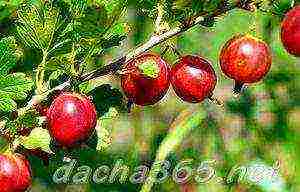 The bushes of the plant are covered with thorns. The fruits are large, the weight of one varies from 3 to 5.9 grams. The color of the berries is pink, the pulp is sweet and sour in taste, has a wonderful aroma.
The bushes of the plant are covered with thorns. The fruits are large, the weight of one varies from 3 to 5.9 grams. The color of the berries is pink, the pulp is sweet and sour in taste, has a wonderful aroma.
"Candy" is resistant to frost, does not need pollination. Each season brings from 1.9 to 6.3 kg per bush. Has immunity against powdery mildew and anthracnose.
This variety has a minus, "Candy" often becomes a victim of septoria. It is recommended to grow in the regions of Western and Eastern Siberia.
"Cooperator"
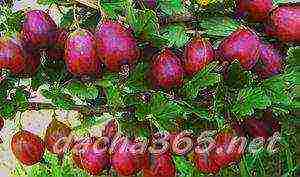 Has a medium late ripening period. Medium-sized plant with slightly spreading crown. The branches have practically no thorns. The weight of one berry is about 7 grams, the shape is pear-shaped, the skin color is deep red.
Has a medium late ripening period. Medium-sized plant with slightly spreading crown. The branches have practically no thorns. The weight of one berry is about 7 grams, the shape is pear-shaped, the skin color is deep red.
The pulp is tasty and sweet. From one bush, you can collect up to 5 kg of berries. "Cooperator" is a dessert variety. The species is not susceptible to the appearance of fruit rot and is resistant to frost.
"Leningradets"
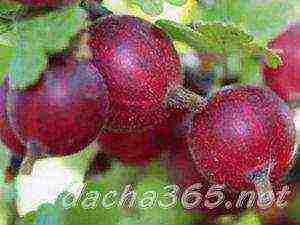 Medium-sized plant with a semi-spreading crown, few thorns on the branches. Has a medium late ripening period. The fruits are large, in the form of an egg, the weight of one is about 10 grams. The color of the berries is red, the flesh tastes sweet and sour. During the season, up to 7.6 kg of ripe gooseberries can be harvested from one bush. "Leningradets" tolerates low temperatures well and is not susceptible to the spread of powdery mildew.
Medium-sized plant with a semi-spreading crown, few thorns on the branches. Has a medium late ripening period. The fruits are large, in the form of an egg, the weight of one is about 10 grams. The color of the berries is red, the flesh tastes sweet and sour. During the season, up to 7.6 kg of ripe gooseberries can be harvested from one bush. "Leningradets" tolerates low temperatures well and is not susceptible to the spread of powdery mildew.
"Spring"
 A plant of medium height forms a neat crown. The weight of one berry is from 5 to 6 grams, with proper care, the weight can increase to 8 grams. The fruits are round, oblong. The skin is dense, yellowish-green in color. The fruit pulp is sweet and tasty. Can be consumed both fresh and processed. "Rodnik" tolerates frost well and is resistant to the appearance and spread of fungal diseases.
A plant of medium height forms a neat crown. The weight of one berry is from 5 to 6 grams, with proper care, the weight can increase to 8 grams. The fruits are round, oblong. The skin is dense, yellowish-green in color. The fruit pulp is sweet and tasty. Can be consumed both fresh and processed. "Rodnik" tolerates frost well and is resistant to the appearance and spread of fungal diseases.
Interesting! Unfavorable weather conditions will not interfere with harvesting a rich crop from the bush.
The best winter-hardy gooseberry varieties
"Beryl"
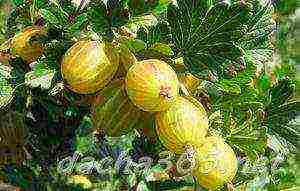 The shrub is medium in size, the branches form a neat crown. There are often thorns at the bottom of the shoots. The mass of one berry is from 7.9 to 9 grams, a round-shaped gooseberry of a greenish tint. It has excellent taste and belongs to the dessert varieties. Up to 9 kg of a mature crop can be harvested from one bush per season. "Beryl" is resistant to low temperatures up to - 35 degrees. Has immunity against fruit rot.
The shrub is medium in size, the branches form a neat crown. There are often thorns at the bottom of the shoots. The mass of one berry is from 7.9 to 9 grams, a round-shaped gooseberry of a greenish tint. It has excellent taste and belongs to the dessert varieties. Up to 9 kg of a mature crop can be harvested from one bush per season. "Beryl" is resistant to low temperatures up to - 35 degrees. Has immunity against fruit rot.
"Commander"
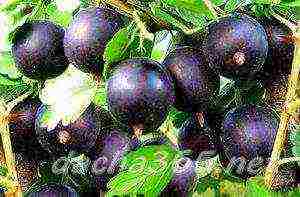 The variety obtained as a result of crossing "African" and "Chelyabinsk green". It has many benefits.
The variety obtained as a result of crossing "African" and "Chelyabinsk green". It has many benefits.
The crown of the plant is compact and dense, the shoots have thorns. The branches of the shrub are dotted with many berries of almost black color, the pulp of which has a pleasant taste.
"Ural Emerald"
 The plant has a medium-sized crown, not very tall, there are few thorns on the shoots. The fruits are smooth, have no pubescence, the weight of one unit is about 8g. The Ural Emerald is so called because the berries growing on its branches are bright. The pulp is tasty and aromatic. Ripe fruits can only be harvested 3-4 years after planting the shrub. The variety tolerates frost well and will not suffer at temperatures down to -37 degrees.
The plant has a medium-sized crown, not very tall, there are few thorns on the shoots. The fruits are smooth, have no pubescence, the weight of one unit is about 8g. The Ural Emerald is so called because the berries growing on its branches are bright. The pulp is tasty and aromatic. Ripe fruits can only be harvested 3-4 years after planting the shrub. The variety tolerates frost well and will not suffer at temperatures down to -37 degrees.
"Consul"
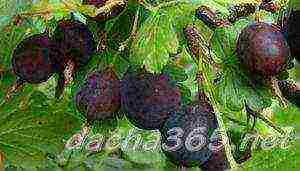 The variety has another name - "Senator". The plant is compact, medium in size with a dense crown and branches covered with thorns. The fruits are large, the weight of one unit is about 6 grams. The color of the berries is dark burgundy, rich. The skin is delicate and prone to damage, therefore it is not recommended to transport this type of gooseberry. Excellent cooking is obtained from the pulp, because there are practically no seeds inside.The plant is resistant to frost down to -38 degrees. The yield increases several times for 2-3 years after planting.
The variety has another name - "Senator". The plant is compact, medium in size with a dense crown and branches covered with thorns. The fruits are large, the weight of one unit is about 6 grams. The color of the berries is dark burgundy, rich. The skin is delicate and prone to damage, therefore it is not recommended to transport this type of gooseberry. Excellent cooking is obtained from the pulp, because there are practically no seeds inside.The plant is resistant to frost down to -38 degrees. The yield increases several times for 2-3 years after planting.
"Belorussian"
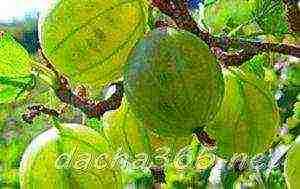 The plant is compact, small. The branches are studded with many thorns. The fruits are round, the weight of one unit is about 8 grams. The skin is thin, deep green in color, has a shade that repeats the color tone of malachite. The pulp is pleasant to the taste, juicy and sweet. The variety is a representative of an old selection. "Belorussky" is resistant to low temperatures up to - 38.5 degrees. Has an average ripening period.
The plant is compact, small. The branches are studded with many thorns. The fruits are round, the weight of one unit is about 8 grams. The skin is thin, deep green in color, has a shade that repeats the color tone of malachite. The pulp is pleasant to the taste, juicy and sweet. The variety is a representative of an old selection. "Belorussky" is resistant to low temperatures up to - 38.5 degrees. Has an average ripening period.
"Krasnoslavyansky"
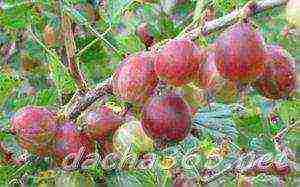 The plant is of medium size, the crown is not dense, it is formed by slightly spreading branches on which there are thorns. The gooseberry is large, round in shape, the weight of one unit is about 9 grams. The skin is smooth, without fluff and bloom, rich red color. Berries belong to dessert varieties, they have a pleasant taste.
The plant is of medium size, the crown is not dense, it is formed by slightly spreading branches on which there are thorns. The gooseberry is large, round in shape, the weight of one unit is about 9 grams. The skin is smooth, without fluff and bloom, rich red color. Berries belong to dessert varieties, they have a pleasant taste.
It's important to know! "Krasnoslavyansky" bears fruit the next year after planting. After a couple of years, 6 to 7 kg of ripe gooseberries can be harvested from the bush. The species tolerates frost well and is not susceptible to powdery mildew.
The best studless gooseberry varieties
"Eaglet"
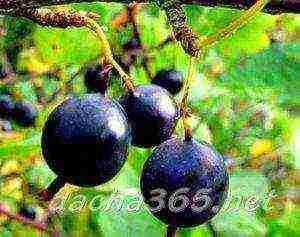 Bushes of medium height form a compact crown. The branches are smooth, without thorns. The variety is very popular in Russia among summer residents and gardeners. The mass of one berry is from 4 to 6 grams. Skin color is deep black. Above, the gooseberry covers a layer of plaque, under which thin skin and sweet and sour flesh are hidden. "Eaglet" ripens early and bears a good harvest every season. The species is not susceptible to the appearance of fruit rot and tolerates frost well.
Bushes of medium height form a compact crown. The branches are smooth, without thorns. The variety is very popular in Russia among summer residents and gardeners. The mass of one berry is from 4 to 6 grams. Skin color is deep black. Above, the gooseberry covers a layer of plaque, under which thin skin and sweet and sour flesh are hidden. "Eaglet" ripens early and bears a good harvest every season. The species is not susceptible to the appearance of fruit rot and tolerates frost well.
"African"
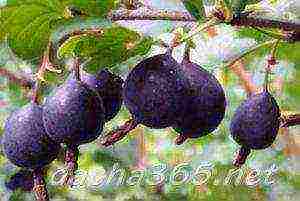 The plant is compact, small, smooth branches without thorns. The fruits are large, round, deep purple in color. Represents sweet varieties. The pulp is sweet with sourness, has a black currant flavor. Berries on the shoots appear in 2-3 years. "African" is not afraid of frost and has immunity against many diseases. There is a risk of contracting anthracnose.
The plant is compact, small, smooth branches without thorns. The fruits are large, round, deep purple in color. Represents sweet varieties. The pulp is sweet with sourness, has a black currant flavor. Berries on the shoots appear in 2-3 years. "African" is not afraid of frost and has immunity against many diseases. There is a risk of contracting anthracnose.
"Northern Captain"
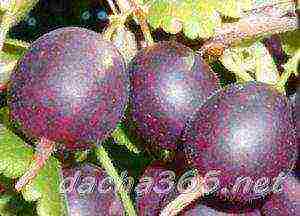 The most famous of all varieties of this garden culture. The branches of the plant are arranged vertically, they form a neat and compact crown. The color of the berries is rich, almost black. The weight of one unit is about 4 grams. The pulp is sweet, with a slight sourness, pleasant to the taste. The "Northern Captain" matures in the medium term. If you constantly feed and fertilize the soil, you can achieve high yields, about 12 kg of berries from a bush. The variety is resistant to frost, drought and disease.
The most famous of all varieties of this garden culture. The branches of the plant are arranged vertically, they form a neat and compact crown. The color of the berries is rich, almost black. The weight of one unit is about 4 grams. The pulp is sweet, with a slight sourness, pleasant to the taste. The "Northern Captain" matures in the medium term. If you constantly feed and fertilize the soil, you can achieve high yields, about 12 kg of berries from a bush. The variety is resistant to frost, drought and disease.
"Uralsky beshipny"
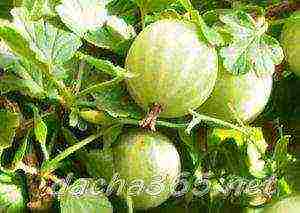 The plant is compact in size with large green fruits. The weight of one unit is about 8 grams. The peel of the berries is dense, smooth, without fluff, hiding the sweet pulp. "Uralsky beshipny" has an average ripening period and is resistant to low temperatures.
The plant is compact in size with large green fruits. The weight of one unit is about 8 grams. The peel of the berries is dense, smooth, without fluff, hiding the sweet pulp. "Uralsky beshipny" has an average ripening period and is resistant to low temperatures.
Healthy! The disadvantage of this type is that it drops the berries ahead of time. Therefore, it is better to harvest the fruits before the stated ripening period. The branches of the shrub have no thorns.
"Thornless gooseberry"
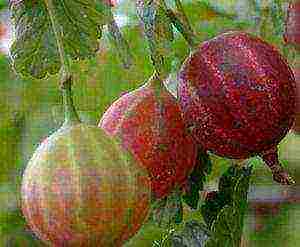 The branches of the shrub grow upward, they form a compact crown. The weight of one fruit is about 5 grams. The shape of the berries is ring-shaped, the skin is light red.
The branches of the shrub grow upward, they form a compact crown. The weight of one fruit is about 5 grams. The shape of the berries is ring-shaped, the skin is light red.
The pulp tastes sweet, pleasant with a slight sourness. "Thornless gooseberry" perfectly tolerates the cold season and is not susceptible to the spread of powdery mildew.
Conclusion
When choosing a variety for growing in your garden, you need to pay special attention to the ripening period of the fruits, their size, shape and taste. Both an experienced gardener and an amateur will find a species that will be ideal in all respects, since there are a huge variety of gooseberry varieties.
Watch the video! Overview of gooseberry varieties
Sweet gooseberries are especially good when fresh. They are also used to prepare jelly, jam, wine, add to sauces and use in folk medicine. Plant a bush of this kind on the site and pamper your loved ones with a healthy treat!
Gooseberry is one of the most popular berries in the gardens of many summer residents.It has been known in our latitudes since the 11th century. More than 1,500 gooseberry varieties are cultivated in the world. It is effective as a diuretic and choleretic agent, and is also rich in pectins (these substances help cleanse the body of toxins, radioactive elements and other harmful substances). The traditional taste of gooseberries is sweet and sour, but today let's talk about varieties of gooseberries with sweet berries.
White Nights
Despite the strong thorniness of the shoots and the relative small fruitiness, this gooseberry variety is loved for the sweet taste of the berries. The variety was obtained by crossing the varieties Mysovskiy 17 and Hansa. It has been registered in the State Register of Breeding Achievements since 2000.
The leaves are medium in size, the color of the berries is yellowish. A short, compact bush will not take up much space in the garden. The variety is universal, the fruits are good both fresh and for harvesting. Suitable for growing in the Northwest region.
| Ripening period | Average berry weight (g) | Productivity (kg per bush) | Peculiarities |
| Early | 3,4 | 4,4-6,2 | Winter-hardy, resistant to powdery mildew, slightly susceptible to septoria and anthracnose. |
Candy
The aroma and sweet taste of the berries confirms the name of this gooseberry variety. Plants of this variety tolerate drought well, so the hot summer will not ruin the harvest. The purpose of the variety is universal: it can be used for jam, compotes, as well as fresh.
The spine of the shoots is average, the leaves are small. The peel of the gooseberry variety Candy medium density. Suitable for growing in the West Siberian and East Siberian regions.
| Ripening period | Average berry weight (g) | Productivity (kg per bush) | Peculiarities |
| Average | 3,1 | 1,8-6,2 | Frost-resistant variety, average resistance to pests and diseases. |
Pink 2
The cultivar was obtained by crossing the Lefora and Dates seedlings. This sweet large gooseberry (berry weight can be up to 10 g) will appeal to both those who like to taste the berry "from the bush" and hostesses who prefer to make gooseberry preparations.
The skin of the fruit is dense, which allows you to transport the berry without fear of spoiling the harvested crop. The spine is not high. The variety is suitable for growing in the Central and East Siberian regions, but demanding on conditions.
| Ripening period | Average berry weight (g) | Productivity (kg per bush) | Peculiarities |
| Mid-early | 5-6 | 3-5 | High resistance to septoria, powdery mildew, anthracnose. |
WITHEjan Lefort
Weak spine of the shoots, as well as consistently good yield in addition to the excellent taste of the berries - these are the advantages for which this versatile gooseberry variety is loved. The berries of the Lefora Seedling variety have a thin skin and a bright aroma.
Suitable regions for growing gooseberry varieties Seyanets Lefora: North, North-West, Volgo-Vyatsky, Uralsky, West Siberian.
| Ripening period | Average berry weight (g) | Productivity (kg per bush) | Peculiarities |
| Mid-early | 3,8 | 2,1-3,7 | Highly resistant to powdery mildew, winter-hardy. Resistance to septoria and spheroteca is average. |
Cooperator
Distinctive features of the Kooperator variety: low spine of shoots, large size and sweet dessert taste of berries. The bush is not sprawling, compact and at the same time dense. From below, almost to the middle of the bush, the shoots are covered with a pinkish bloom ("tan").
Delicious confitures, preserves, compotes are obtained from the gooseberries of this variety. The variety was included in the State Register in 1999 and is perfect for growing in the Ural region.
| Ripening period | Average berry weight (g) | Productivity (kg per bush) | Peculiarities |
| Average | 3,6-8,0 | 3,7-6,9 | Resistant to anthracnose, powdery mildew and sawfly beetle attacks. It is moderately resistant to septoria. |
Belarusian sugar
The variety, bred at the Institute of Fruit Growing of the National Academy of Sciences of Belarus, is popular among those who prefer the sweet taste of berries. The bush is compact, but rather tall. The spine of the shoots is average.
The gooseberry of this variety grows well in loamy and clayey soils, "gets along" well next to other crops, and gives a bountiful harvest for 12-18 years.
| Ripening period | Average berry weight (g) | Productivity (kg per bush) | Peculiarities |
| Average | 4,1-8,5 | 3,5-6 | Medium resistance to anthracnose and powdery mildew. |
Russian yellow
A spontaneous yellow-fruited clone of the Russkiy variety. Compared to the "relative", the berries are more delicate in taste. The spine of the shoots is weak. The bush is of medium height, compact. Ripe fruits are able to stay on the bush for a long time without cracking.
This versatile variety was included in the State Register in 1974. Suitable for growing in the North-West and Ural regions.
| Ripening period | Average berry weight (g) | Productivity (kg per bush) | Peculiarities |
| Average | 5-7 | 4,1 | Relatively resistant to powdery mildew. High winter hardiness and good transportability. |
Sirius
In spite of its small fruit, the gardeners fell in love with the gooseberry of the Sirius variety thanks to the delicate, sweet taste of the berries. Suitable for making jam, compote, etc. It is no less tasty when fresh.
The bush is compact, straight in shape. The Sirius variety is drought-resistant. Suitable for growing in the Central Black Earth Region.
| Ripening period | Average berry weight (g) | Productivity (kg per bush) | Peculiarities |
| Mid late | 2,7-3,5 | 4-7,3 | High frost resistance, resistance to powdery mildew. |
Beryl
This variety is the "brainchild" of the varieties Nugget and Malachite. The bush has a dense, medium-spreading crown, the spine of the shoots is weak. The berries are not very large, but very sweet.
The variety is universal: the fruits are eaten both fresh and in the form of jams, compotes, confitures. Suitable for growing in the Ural and West Siberian regions.
| Ripening period | Average berry weight (g) | Productivity (kg per bush) | Peculiarities |
| Average | 2,8-3,4 | 3,1-9 | A winter-hardy variety, resistant to powdery mildew, but not too resistant to septoria. |
Chernomor
The berries of this gooseberry are not very large, however, Chernomor is one of the "sweetest" varieties. The spine of the shoots is weak, the bush is tall and spreading.
Used for the preparation of blanks or consumed fresh. The variety is also distinguished by drought resistance. Recommended for cultivation in the Central region.
| Ripening period | Average berry weight (g) | Productivity (kg per bush) | Peculiarities |
| Mid late | 3 | 3,1-4 | High winter hardiness. Resistant to powdery mildew, as well as moth. |
If you have already chosen the right sweet gooseberry variety for your garden, we suggest reading our material on how to plant this plant correctly:
Gooseberry, this thorny shrub is at least one specimen, but it must be found on every garden plot. This culture has a rich history and has been known to man for a very long time. Gooseberry was once grown on a large scale in our country, but most of its plantings were destroyed by powdery mildew brought from another continent. It took years for breeders to be able to develop varieties that are resistant to this ailment, and now the demand for gooseberry planting material and the area under this crop is increasing every year.
Various varieties of gooseberries
At the moment, there are 46 varieties of this wonderful crop in the State Register of Breeding Achievements of the Russian Federation, the very first varieties of gooseberries were obtained back in 1959, these are the varieties: Malachite, Russian, Seianets Lefora, Smena and Chelyabinsk green. New items introduced in the 21st century: White Nights, Defender, Kazachok, Candy, Favorite, Narodny, Spring, Northern Captain, Serenade, Snezhana, Ural Emerald, Ural Pink, Flamingo, Shershnevsky and Eridan.
Each of these gooseberry varieties is recommended for one or several regions of the Russian Federation, selected in accordance with a number of climatic features.There are 12 such regions in total, one or another gooseberry variety is recommended for each of them. Let's take a closer look at the varieties and find out for which of the regions this or that cultivar is recommended.
Let's start with the variety Harlequin, it was received in 1995 and recommended for regions 9 and 10 - Ural and West Siberian... This gooseberry variety is characterized as late, it is a shrub, it is characterized by an average vigor of growth, an average spreading crown and has rather large leaf blades of green color. There are usually three flowers in the inflorescence of this variety. After flowering, the berries are tied, they are red in color, round in shape, with a taste estimated by tasters at 4.4 points out of 5 possible. Fruits contain up to 6.0% sugars, more than 3% acids, over 24 mg% ascorbic acid. The yield per bush reaches 2.5 kg. The variety is not affected by powdery mildew, rarely damaged by the sawfly.
Cultivar White Nights was launched in 2000 and recommended for cultivation in the second, Northwest region... The fruits of the variety ripen early. The plant itself is a very modest bush with straight, thorny shoots. The leaf blades are medium in size and green in color. In the inflorescence there is usually one, less often - two flowers. Gooseberry fruits weighing about 3.5 g, their shape is round, yellow-green in color, there is a slight pubescence. Tasters rate the taste at 4.3 points, the appearance at 4.4 points. Each berry contains up to 10.9% sugars, over 1.8% acids, up to 30 mg% ascorbic acid. The maximum yield per bush is 3.1 kg. The variety is resistant to powdery mildew.
Gooseberry variety Beryl was included in the State Register in 1998 and recommended for growing in regions 9 and 10 - Ural and West Siberian... It is a medium-sized shrub with a slightly spreading crown. Shoots are usually curved, have spines only on the bottom. The leaf blades are rather large. There are two flowers in the inflorescence. The fruits are round, weighing about 3.5 g, yellow-green in color with a skin devoid of pubescence. Tasters rate the taste of berries at 4.4 points, the attractiveness of the appearance - at 4.5 points. Each berry of this variety contains up to 9.8% sugars, about 0.5% acids, more than 38 mg% ascorbic acid. The maximum yield per bush is about six kilograms. The variety is resistant to powdery mildew and has a high winter hardiness.
Gooseberry cultivar Harlequin Gooseberry cultivar White nights Gooseberry cultivar Beryl
Vladil, - this gooseberry variety was obtained in 1995 and recommended for cultivation in 2, 4, 7, 9 and 10 regions, these are the North-West, Volgo-Vyatka, Middle Volga, Ural and West Siberian regions... The harvest of this variety ripens early. Plants of the variety are actively growing shrubs with a slightly spreading crown. The leaf blades are rather large, dark green in color with shine. There can be two or three flowers in the inflorescence. The fruits of the variety reach a mass of 2.9 g, they are red, quite tasty, tasters estimate this indicator at 4.3 points, and the appearance - at 4.4 points. Berries contain up to 15% sugars, more than 2.8% acids, over 28 mg% ascorbic acid. The maximum yield of the variety is about two kilograms per bush. The cultivar is immune to powdery mildew, but can be damaged by the sawfly.
Defender, - this gooseberry variety was obtained relatively recently, in 2010 and recommended for cultivation in the third, Central, region... The variety is characterized by late ripening. Plants of this variety are actively growing shrubs with straight shoots, completely covered with thorns, and large leaf blades of a dark green color. Each inflorescence can have from one to three flowers. The fruits of this species are oval-pear-shaped, dark red, almost black, in color and a noticeable waxy coating. The average weight of the fruit is about 4.9 g. The taste of the berries is quite pleasant, by tasters it is rated at 4.5 points, and the appearance - at 4.6 points. The maximum yield per bush reaches 5.6 kilograms.The variety is drought-resistant, winter-hardy, but can be affected by powdery mildew.
Kazachok, - this gooseberry variety was included in the State Register in 2006 and recommended for growing in the fifth region - Central Black Earth... The ripening period for the variety is medium late. Plants of the variety are shrubs with medium vigor and a spreading crown due to their curved shoots. The leaf blades are bright green in color. In an inflorescence there can be either one or two flowers. The fruits of the variety have a mass of about 3.6 g, they are oval, dark red in color, slightly pubescent. The taste of the berries is quite pleasant, tasters rate it at 4.9 points, which is a very high rating. Each berry of the Kazachok variety contains up to 11.7% sugars, about 1.4% acids, up to 39.8 mg% ascorbic acid. The maximum yield per plant reaches eight kilograms. The variety is resistant to powdery mildew.
Gooseberry variety Vladil
Gingerbread man, - this gooseberry variety was obtained in 1988, it recommended for growing in 3, 4, 5 and 11 regions, that is, in Central, Volgo-Vyatka, Central Black Earth and East Siberian... The variety is characterized by an average ripening period and high yield, reaching six kilograms per bush. The plant of the variety is a medium-sized bush with a rather dense and spreading crown. The thorns on the shoots are small, there are few of them. In inflorescences there can be either one or two flowers. The fruits are very large, can reach a mass of 8.1 g, they are round, dark red. Taste qualities are estimated at 4.6 points. The variety is resistant to powdery mildew.
Candy, - this cultivar was included in the State Register in 2008 and recommended for cultivation in 10 and 11 regions - West Siberian and East Siberian... The variety is characterized by an average ripening period. Plants of the variety are shrubs of medium growth with a compact crown and rather thin shoots. Thorns, like shoots, are thin, located singly and usually only in the lower part of the shoot. In an inflorescence there can be either one or two flowers. Fruits of the variety are medium-sized, spherical, red in color. The gooseberry taste is quite pleasant, it is estimated by the tasters at 4.7 points. The average weight of the fruit is about 3.2 g. Each berry contains up to 8.7% of sugars, more than 1.1% of acids, and more than 55.1 mg of ascorbic acid. The maximum yield of the variety reaches 2.4 kg per bush. The variety is resistant to drought, not afraid of frost.
Cooperator, - gooseberry variety obtained in 1999 and recommended for two regions - 9 and 11, these are the Ural and East Siberian... The crop ripens in the middle late terms. The maximum yield often exceeds six kilograms per bush. Plants of the variety are shrubs of medium height, with a compact, moderately spreading crown. Shoots have thorns only in the lower part, which makes harvesting somewhat easier. There can be two or three flowers in the inflorescence. Fully ripe gooseberry fruits reach a mass of 7.6 g, are pear-shaped and dark red in color, sometimes they look black. The taste is very pleasant, it is considered dessert, its tasters estimate it at 4.9 points. The variety is resistant to powdery mildew.
Gooseberry variety KolobokGooseberry variety CandyGooseberry variety Cooperator
Krasnoslavyansky, - this gooseberry variety was included in the State Register in 1992 and recommended for three regions at once - 2, 3 and 4, these are North-West, Central and Volgo-Vyatka... The harvest of this variety ripens in medium terms, the yield is quite high, reaching seven kilograms per bush. Plants of the variety are small shrubs with a slightly spreading crown. The thorns are small and there are not many of them. The fruits are very large, up to 9 grams, their shape is round, the color is dark red, slightly pubescence is noticeable on the surface. The pulp of the berries is very tasty, tasters rated the taste at 4.5 points. The variety is resistant to powdery mildew.
Red large, - it was received in 1974 and recommended for cultivation in the tenth region - West Siberian... Interestingly, this gooseberry variety was obtained from a seedling that accidentally grew, its parents are unknown. The variety is characterized by medium ripening, high winter hardiness and resistance to a complex of diseases and pests. Productivity ranges from three to four kilograms of fruit from a bush over the years. The plants themselves are of medium vigor and quite sprawling. There are thorns in abundance on old shoots, there are very few of them on young ones. The berries are not large, reaching a mass of 3.1 g. The shape of the fruits is elongated-oval, the color is dark red. The taste is quite pleasant, it is rated by tasters at 4.5 points.
Kubanets, - this gooseberry variety was bred in 1997 and zoned in only one region - 6, North Caucasian... The harvest on low and slightly spreading bushes of this variety ripens early. It is easy to collect because the thorns on the thick and straight shoots are located only in the lower part. Ripe berries have an oval shape, green color, do not have pubescence and reach a mass of 5.7 g. The maximum yield from a gooseberry bush reaches 9.4 kilograms on good soil. The fruits of the variety are tasty, tasters rate the taste at 4.5 points, and the appearance at 4.6 points. Each berry contains up to 7.7% sugars, about 2.2% acids, over 33 mg% ascorbic acid. The variety is resistant to powdery mildew and does not require pollinating varieties on the site.
Gooseberry variety Krasnoslavyansky Gooseberry variety Red large Gooseberry variety Kubanets
Cultivar Beloved, - it was included in the State Register at the very beginning of the current century - in 2000 and recommended for growing in the 10th region, West Siberian... Berries on the spreading bushes of this gooseberry variety ripen quite early, it is not very convenient to collect them: very thick shoots are covered with no less thick thorns. However, the berries are worth the trouble of picking, they have an oval shape, weigh about 4.0 g, a yellow-green color of dense skin covered with a waxy coating and a rather pleasant taste, albeit without aroma, rated by tasters at 4.9 points. Each fruit contains up to 8.8% sugars, about 2.0% acids, more than 43 mg% ascorbic acid. The yield of the variety is very high and on good soil reaches 8.7 kg per bush. The advantages of the variety include its winter hardiness, resistance to powdery mildew and relative resistance to the sawfly.
Malachite, - an old gooseberry variety, 1959, but it is he who is most often found in summer cottages. The variety is zoned in many regions, it is easier to say in which cultivation is not desirable, these are regions 6, 10 and 11, namely the North Caucasian, West Siberian and East Siberian... The harvest on vigorous and slightly spreading bushes ripens in medium terms. The maximum yield is about four kilograms per bush. The harvest will have to be done with care, because small thorns are scattered over the entire surface of the shoots. However, no one leaves Malachite berries on the shoots, they say that the most delicious jam comes from the fruits of this variety. By the way, the fruits cannot be called small, they reach a mass of 7.1 g, have a slightly elongated shape and a rich green color. The taste is pleasant, the tasters are rated at 4.6 points. The variety is resistant to powdery mildew.
Lighthouse, - this gooseberry variety is newer, it is included in the State Register in 1992 and zoned only in one region - in the North-West (2)... Harvest on well-developed bushes with arched shoots ripens in medium terms. Harvesting is not very easy: the shoots have very sharp thorns, which are sometimes very densely distributed. The mass of berries is not a record - about 3.3 g, the yield is also at an average level - about 5.2 kg per bush. Why is the variety good? Pleasant dark red color of berries, good taste, estimated by tasters at 4.3 points, and high sugar content in them - more than 10.5%. In addition, the variety is characterized by high winter hardiness and resistance to powdery mildew.
Gooseberry variety Lyubimets Gooseberry variety Malachite Gooseberry variety Lighthouse
Gooseberry variety Reliable - included in the State Register in 1994 and recommended for cultivation in three regions at once - West Siberian (10), East Siberian (11) and Far East (12)... The harvest on these winter-hardy bushes with a very compact crown ripens in medium terms. With a fruit weight of 3.1 grams, up to 6.3 kg of fruit can be harvested from a bush. Each berry has an oval shape, pink color and a rather pleasant pulp, although due to the perceived acidity, tasters give the taste only 4.1 points. The fruits contain a lot of sugars, more than 11.8%. The variety is resistant to powdery mildew.
A relatively new variety of gooseberries - People's, it was received in 2009 and zoned in the West Siberian region (10)... The harvest on vigorous bushes of this variety ripens late, which allows to extend the period of consumption of fresh berries. It is quite convenient to pick berries, because there are thorns only at the bottom of the shoots. The mass of the berries is average - about 3.3 points, they are round and dark red in shape. The taste is very pleasant, judged by tasters at 4.9 points, but the yield is not very high, only 3 kg per bush. Of the advantages, we can note resistance to pests and diseases and drought resistance.
Cultivar Rainbow was included in the State Register at the very end of the 20th century, in 1999, he zoned in the West Siberian (10) region... The harvest on medium-sized plants of the variety ripens in medium terms. Picking berries is not so easy, since the thin shoots of the variety are literally dotted with thorns. The berries of this gooseberry variety are not very large, about 2.8 g, but the yield cannot be called low, often it exceeds 6.9 kg per bush. When fully ripe, the fruits of the Raduzhny variety turn into a pleasant, red color, they have an average skin density and a rather pleasant taste, assessed by tasters at 4.9 points. Fruits contain a lot of sugars - more than 8.1% and few acids, less than 1.8%. The variety is only occasionally affected by diseases and damaged by pests.
Gooseberry variety Narodny
The gooseberry variety is considered even newer. Spring, it was received in 2002 and zoned in the Central (3) region... The harvest on medium-sized bushes of this variety ripens early. It is quite easy to pick the berries, since the thick shoots of the variety have thorns only in the lower part. When fully ripe, the berries are yellow-green in color with a slight pink tan on the south side and a rounded oval shape. The weight of the fruits is not bad - just over 5.1 g, but the yield cannot be called a record one, on good soil it reaches 5.8 kg per bush, which, however, is also not bad. There are quite a lot of sugars in the fruits - more than 7.0%, which gives the berries a pleasant taste, it is not for nothing that tasters rate it at 4.9 points. The variety, among other things, is winter-hardy and almost never gets sick.
A rather old variety of gooseberry, which, nevertheless, has not lost its demand, is Pink 2... It was included in the State Register in 1971 and zoned in several regions at once - Central (3) and East Siberian (11)... The harvest on medium-sized bushes of this variety ripens in medium terms. The yield is not very large - about 4 kg per bush, however, the advantages of this variety are that, thanks to the small number of thorns, the berries are easy to pick and they are very tasty due to the large amount of sugar. The mass of berries often reaches 9.8 g, they have a round-oval shape and pinkish-red color. The fruits of this variety are simply excellent in various types of processing, and the plants themselves rarely get sick and are winter-hardy.
Russian, - the gooseberry variety was included in the State Register in 1959, but it is still very popular. The variety is zoned in almost all regions, with the exception of the Ural region (9)... The harvest on vigorous bushes of this variety ripens in medium terms. From a bush, you can collect up to ten kilograms of fruit on good soil, this is a record among gooseberry varieties. The berry weight is also quite good - up to 6.1 g. Each berry is oval and dark red in color.The taste of ripe fruits is quite good, rated by tasters at 4.6 points. Of the positive qualities of the variety, one can note good winter hardiness and resistance to powdery mildew.
Gooseberry cultivar Rodnik Gooseberry cultivar Pink 2 Gooseberry cultivar Russian
Salute, - this gooseberry variety appeared in the State Register in 1994, it is zoned in three regions - North-West (2), Central (3) and Volgo-Vyatka (4)... The harvest on medium-sized bushes of this variety ripens in medium terms. The maximum yield reaches seven kilograms per bush, with a berry weight of 6.7 grams. Taste qualities of Salut fruit are very high, tasters rate the taste at 4.9 points. The fruits themselves are round-oval in shape and bright pink in color. Of the undoubted advantages of the variety, one can note its high winter hardiness and immunity to powdery mildew.
Gooseberry variety Northern captain, - fairly new, it was included in the State Register in 2007, but zoned only in the North-West (2) region... The harvest on vigorous bushes of this variety ripens in the middle late periods. It is quite convenient to collect it because of the almost simultaneous ripening of berries and rather rare thorns. Fully ripe, the berries are round and dark red, almost black. The taste is quite pleasant, thanks to the large amount of sugars (9.1%), it is rated by tasters at 4.5 points. The yield is not very high, only 1.7 kg per bush with a berry weight of 2.5 g. Among the advantages of the variety are winter hardiness and high resistance to pests and diseases.
Cultivar Northerner went on sale in 1991 and immediately gained popularity, especially in those regions where it is zoned - Middle Volga (7) and West Siberian (10)... The crop on medium-sized bushes of this variety ripens late. It is difficult to collect berries, because the thick and straight shoots are completely covered with thorns. The mass of berries in the gooseberry variety is quite large, reaching 8.1 grams, but the yield cannot be called outstanding, it rarely exceeds 3.8 kilograms. Ripe berries have a round-oval shape, yellow-green color and a fairly dense skin. Tasters rate the taste according to the highest score. Of the advantages of the variety, one can note the weak spreading of the bush and high winter hardiness.
Gooseberry variety Salute Gooseberry variety Northern Captain Gooseberry variety Severyanin
Gooseberry variety Senator was bred in 1995 and zoned in the Volga-Vyatka region (4), Ural (9), West Siberian (10) and Far Eastern (12)... The harvest on vigorous plants of this variety ripens in medium terms. It is quite convenient to collect berries, because there are few thorns. The mass of the berry is not very high, about 3.4 g, which is why the yield cannot be called great, on average no more than 2.6 kg can be harvested from an adult bush. The shape of the fruit is oval, the color is scarlet-red. Fruits contain up to 6.8% sugars and a lot of ascorbic acid. The berry taste is considered dessert and is rated by the tasters at 4.8 points. From the advantages of the variety, resistance to frost and powdery mildew can be distinguished.
A fairly new variety of gooseberries - Serenade, it was received in 2004 and recommended for cultivation in the Central Black Earth region (5)... The harvest on vigorous and slightly spreading plants of the variety ripens at a later date. With a berry mass of 4.1 g, up to four kilograms of fruit can be harvested from a bush. The berries themselves have an elongated-conical shape and a violet-red color, a skin of medium density and a pleasant taste (4.6 points), which, among other things, provides a high sugar content - up to 10.2%. Of the advantages, first of all, it is worth noting high winter hardiness and drought resistance.
A gooseberry variety with an interesting name - Seedling Lefora was bred in 1959. This variety zoned in many regions - North (1), North-West (2), Volgo-Vyatka (4), Ural (9) and even West Siberian (10)... Now this variety is difficult to get, only true fans of this culture have it.Why is the variety good? It is characterized by high winter hardiness, resistance to powdery mildew and a fairly high yield (about five kilograms per bush) with an average berry weight of only 2.5 grams. By the way, the berries are quite tasty and are rated by tasters at 4.5 points. When fully ripe, they are deep red and have a very pleasant aroma.
Gooseberry variety SerenadeGooseberry variety SenatorGooseberry variety Lefora seedling
Sirius, Is another interesting gooseberry variety obtained in 1994 and zoned in the Central Black Earth (5) region... The harvest from a vigorous shrub can be harvested in medium terms. The yield, by the way, is quite good - up to 7.4 kg per bush with a fruit weight of 3.6 grams. Harvesting is a pleasure because the shoots are devoid of thorns. When fully ripe, the berries are round and dark red in color with a noticeable waxy bloom. The fruit taste is pleasant (4.1-4.3 points). Among the advantages of the variety, one can note its high winter hardiness and resistance to powdery mildew.
Plum, - the variety was obtained in 1986, but to this day it is in considerable demand. It is zoned in three regions at once - Central Black Earth (5), Middle Volga (7) and Ural (9)... The positive features of the variety are, of course, its record yield, reaching an almost insurmountable 12 kg per bush on nutrient soil, a rather high weight of fruits - about 6.6 g and their pleasant taste, which tasters estimate at 4.6 points. What are the disadvantages? These are its thorns, they are powerful, they can be double or even triple and occupy the entire surface of the shoots, therefore, it is very difficult to harvest the crop. The gooseberry variety is bought for the sake of berries, so Plum can be safely planted on your site. The berries are large, tasty, dark red, which makes them black from a distance with a very delicate pulp and aroma, like a plum, hence the name. In addition, the variety is drought-resistant and immune to powdery mildew.
A pretty old gooseberry variety Change, entered in the State Register in 1959. This variety is unique primarily in that it zoned in almost all, with the exception of only 6 and 11 regions, that is, the North Caucasian and East Siberian... The crop on medium-sized bushes resistant to powdery mildew is ready for harvest in the middle late periods. Up to six kilograms of fruit can be harvested from one adult bush, given that the mass of one berry usually does not exceed 2.6 g. you can be patient. Of the undoubted positive qualities, first of all, it is worth noting the absence of crop shedding, the absence of the need for regular pruning and treatments against powdery mildew.
Gooseberry variety Sirius Gooseberry variety Smena Gooseberry variety Plum
Snezhana, - this gooseberry variety is quite young, it was included in the State Register in 2009 and is only gaining momentum in popularity. The variety is zoned in the third region - Central... The harvest on medium-sized, compact plants of the variety ripens at a later date. It is quite easy to collect berries, because there are thorns only at the bottom of the shoots. Fruits, when fully ripe, acquire an oval-pear-shaped shape and a yellow-green color. When consumed, acidity is noticeable and a very dense skin is felt, so the tasters rate the variety at only 4.3 points. The yield of the variety is about 4.7 kg per bush with a berry mass of 4.1 g. The main advantage of the variety is its resistance to pests and diseases.
Stanichny, - a variety that has already gained its fans, because it is included in the State Register back in 1995 and zoned in two regions at once - Volgo-Vyatka (4) and Ural (9)... The fruits of this gooseberry variety ripen in medium terms, due to the presence of self-fertility and the large size of the bush, the yield from an adult plant can reach 3.6 kg, with a berry weight of only 2.7 g.By the way, the fruits, although not large, are very pleasant to the taste, the tasting score is about 4.7 points, they are pink and have an oval shape. Each fruit contains up to 9.8% sugars and some acids. The variety is resistant to powdery mildew.
An interesting variety - Ural grapes, it was included in the State Register in 1979 and now it is quite difficult to find seedlings of this variety. The variety is zoned in the seventh region - Srednevolzhsky... This is a table variety of gooseberries, ripening in the early stages and representing a rather tall bush with a spreading crown and medium shoots, entirely covered with thorns. The yield of the variety is low, only 1-1.5 kg per bush with a berry weight of 2.5 g. The fruits have a rounded shape, emerald green color and a rather thin skin. The fruit taste is pleasant (4.3 points). The variety is winter-hardy, resistant to diseases and pests.
Gooseberry cultivar Ural grapes Gooseberry cultivar Snezhana Gooseberry cultivar Stanichny
Newer gooseberry Ural emerald, it is included in the State Register in 2000 (10 - West Siberian and 11 - East Siberian regions)... The variety is distinguished by an early ripening period, medium height and weak crown spreading. The shoots are quite thick and completely covered with thorns. The yield is higher than that of the Ural grapes and is about 5.5 kg per bush due to the fact that the average weight of each berry reaches 4.4 g. The fruits of this variety are green, have interesting white pulp veins and a round-oval shape. Each berry contains up to 9.5% sugars and only 2% acid. Tasters highly rate the taste of the fruit - up to 4.9 points. Of the advantages, it is worth noting high winter hardiness and resistance to a complex of pests and diseases.
An even newer variety - Ural pink, it was included in the State Register in 2004 and zoned in the 10th region - West Siberian... The harvest of this gooseberry variety ripens in medium terms, the plants are weakly growing with practically no spreading crown, the shoots are completely covered with thorns. The yield from an adult plant is about 3.5 kg with a fruit weight of 3.9 g. The berries are very tasty, the tasters give them the highest score, they have a rounded oval shape and pinkish or dark red (berries ripening on the southern side of the bush) coloring. Each berry contains more than 5% sugars. The variety is quite winter-hardy and practically does not get sick.
Flamingo, - this variety is included in the State Register in 2009 and zoned in 10, West Siberian region... The harvest of this gooseberry variety ripens in medium terms, the shoots of a vigorous and rather spreading bush are thin, having thorns over the entire surface. The yield from an adult plant is about 6.3 kg with an average berry weight of about 3.1 g. The fruits of the variety are ovoid, pink, very tasty (4.6 points). Each berry contains more than 9.8% sugars and only 1.1% acids. The variety is winter-hardy, drought-resistant and resistant to pests and diseases.
Gooseberry cultivar Ural pink Gooseberry cultivar Flamingo Gooseberry cultivar Ural emerald
A gooseberry variety, the exact name of which few will repeat by heart - Hinnonmaen Punainen, received in 1999 and zoned in the North and North-West regions... The crop on medium-sized and slightly spreading bushes of this variety with medium-length shoots, completely covered with thorns, ripens at a later date. From one bush, you can collect about 3.5 kg of berries with an average weight of about 2.9 g, oval in shape and dark red color. The taste of the fruit is pleasant (4.3 points), each containing up to 8.5% sugars and slightly less than 3% acid. The variety almost does not get sick and is winter hardiness.
A very old gooseberry Chelyabinsk green, it was included in the State Register in 1959 and zoned in two regions - Ural and West Siberian... The variety is characterized by a mid-early ripening period and high winter hardiness. In addition, the variety is resistant to powdery mildew and drought, and is also self-fertile. The yield per bush is at the standard level - about 3.5 kg, the weight of the berries is about 2.9 grams.The berries are round-oval, emerald green in color and thin skin. The taste is rated as very good (4.8 points).
Variety Chernomor, well-known and widespread, despite the fact that it was received in 1994. Zoned Chernomor in the Central region, but, in fact, grows well almost everywhere... Ripening period is medium late. The gooseberry variety has high winter hardiness and resistance to various diseases. The yield of the variety is very high - more than 9 kg per bush with a berry weight of 3.1 g. The shape of the berries is round-oval, the color is dark red, and in the berries growing on the southern side of the bush it is almost black. The berry taste is quite good (4.4 points). Berries are ideal for processing.
Gooseberry cultivar Chelyabinsk green Gooseberry cultivar Chernomor
Another very famous and widespread variety of gooseberries is Prune... It was included in the State Register in 1992 and zoned in three regions - Central, Middle Volga and Ural... Everyone who is engaged in the production of homemade wine claims that it turns out from the fruits of this variety much better than from grapes. The variety is characterized by an average ripening period, high winter hardiness and immunity to powdery mildew. The yield of the variety is high - it reaches 8.8 kg per bush with an average berry weight of 4.1 g. It is convenient to collect berries, because there are few thorns on the shoots and they are usually concentrated in their lower part. The shape of the berries is oval, the color is dark red, and on the southern side of the bush, the fruits are even black. The taste is good, it has a specific aftertaste that reminds many of the taste of prunes (4.5 points).
Gooseberry variety Black Cherkashina, - was included in the State Register in 1991 and zoned in the West Siberian and East Siberian regions... The variety is characterized by a medium late ripening period, high winter hardiness and immunity to powdery mildew. The yield of the variety is not very high - about 4.5 kg per bush with an average berry weight of 2.5 g. The harvest is quite convenient, because the thorns are located at the bottom of the shoots. The shape of the berries is pear-shaped, the color is almost black, the taste is medium (4.1 points). The fruits are suitable for all types of processing, but jam turns out to be especially successful.
Shershnevsky, - this gooseberry variety is included in the State Register in 2006 and zoned in four regions at once - the Middle Volga, Ural, West Siberian and East Siberian... The variety is named so unusually because of the thorns on the shoots, they are very long, thick, single or double, but the plus is that they are mostly located at the base of the shoots. The yield of the variety is not very high, no more than 3.2 kg per bush with an average berry weight of 3.5 g. The shape of the berries is round-oval, the color is dark pink with a clearly visible matt bloom, there is no pubescence. The taste of the berries is very pleasant and the tasters give them the highest score. The variety is resistant to drought and frost, practically not affected by pests and diseases.
Gooseberry variety Black Cherkashina Gooseberry variety Shershnevsky Gooseberry variety Prune
A fairly new variety of gooseberries Eridanus, - it is included in the State Register in 2009 and zoned in the Volga-Vyatka region... The variety is characterized by vigorous growth and an average ripening period. Shoots on shoots of medium thickness are located over the entire surface. The yield of the variety is about 2.5 kg per bush with an average berry weight of 3.1 g. The shape of the berries is round-oval, the color is red, the taste is pleasant (up to 4.5 points). Berries contain more than 10.5% sugars. The variety is distinguished by high winter hardiness and drought resistance.
Gooseberry variety YubileynyGooseberry variety Eridan
A very old variety of gooseberries - Anniversary, however, until now, his seedlings are in demand. Jubilee is included in the State Register in 1965 and zoned in the Central Black Earth region... The variety is characterized by an average ripening period, high winter hardiness and resistance to provocative thaws. The yield of the variety reaches 5 kg per bush with an average berry weight of 4.1 g.The shape of the berries is round or oval, the color is deep yellow. The taste is pleasant, thanks to the sweet and juicy pulp (4.5 points). The berries are ideal for processing.
